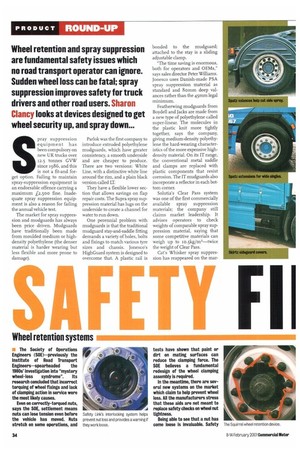Wheel retention systems
Page 36

Page 37

If you've noticed an error in this article please click here to report it so we can fix it.
The Society of Operations Engineers (SOE)—previously the Institute of Road Transport Engineers—spearheaded the 1980s' investigation into "mystery wheel-loss syndrome". Its research concluded that incorrect torquing of wheel fixings and lack of clamping action in service were the most likely causes.
Even on correctly-torqued nuts, says the SOE, settlement means nuts can lose tension even before the vehicle has moved. Nuts stretch on some operations, and tests have shown that paint or dirt on mating surfaces can reduce the clamping force. The SOE believes a fundamental redesign of the wheel clamping assembly is required.
In the meantime, there are several new systems on the market which claim to help prevent wheel loss. All the manufacturers stress that these aids are not meant to replace safety checks on wheel nut tightness.
Being able to see that a nut has come loose is invaluable. Safety
Link and Checkpoint are designed to make sure you can. Tab devices fasten over the wheel nut once it has been tightened to the correct torque, and these are aligned with those on the adjacent nuts. If any nut begins to work loose its tab moves out of alignment with its neighbours, alerting staff that action is required.
The Safety Link has a luminous triangle and interlocking tabs which should prevent further loosening once the tab has moved by T.
Some engineers remain sceptical about how effective these little safety gadgets are, but accept that a visual guide to nuts working loose is a useful maintenance aid.
Some systems are designed to combat the effect of road vibration on nuts. Hatcher Components Safe Wheel is a nut retaining ring made of recyclable plastic; it pushes on over al110-stud wheels. WheelSafe's Squirrel is a one-piece plasticcoated wire shaped around each stud and designed to prevent wheel rotation from loosening the stud.
One company claims to have solved the problem of loose nuts completely. The Disc-Lock wheel nut is split into two sections, each with an interlocking rising cam. The cams rise against each other when subjected to road shock or vibration. The angle of the cams is greater than the pitch angle of the thread on the stud so the nut is said to lock, maintaining the tension in the stud.
At the CV Show, Disc-Lock will be demonstrating the nut's resistance to vibration compared with conventional nuts.
































































































